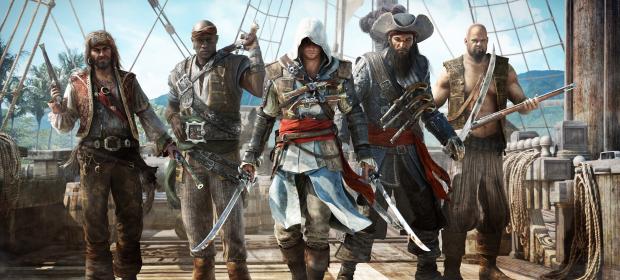With Assassin’s Creed III apparently tying up the Desmond Miles storyline and effectively ending the main arc of the series, fans of Ubisoft’s iconic franchise were left wondering exactly where the story would go next – and very few expected that we would turn abruptly about-face and head backwards along the timeline of Desmond’s ancestry. Assassin’s Creed IV: Black Flag focuses on Edward Kenway, sea-faring grandfather of ACIII’s Connor and father of the rather more interesting Haytham (the protagonist of the previous game’s early hours).
Quite how Ubisoft manage to produce a brand new Assassin’s Creed game every year boggles the mind (multiple development teams or not). The last game was a beast in size, spreading its sweeping adventure all over the American Frontier and introducing a host of new features and gameplay facets to the series’ bulging arsenal, such as hunting and sailing. Black Flag, in a display of true one-upmanship, has taken everything that III brought to the series and heaped on the badass so high you can barely see the horizon. The result is a game that doesn’t always get it right, but sells itself in such a way that you won’t much care.
There’s such a swagger to Black Flag that it’s almost as though Ubisoft recognised the shortcomings of ACIII (indeed, they’re a developer known for listening to feedback) and were so confident during the development of number four that they let their sails down and went with the wind –and it has paid dividends. Arguably, this is the best Assassin’s Creed to date – self-assured, full of character and absolutely brimming with style.

It opens with Edward Kenway chasing down a renegade Assassin named Walpole, whose identity he steals in an attempt to fleece a particularly nasty Spanish politician. Unbeknownst to Kenway, said politician is a high-ranking Templar, and all the young Privateer’s dreams of riches and glory are about to become entwined with the centuries-old conflict between Assassin and Templar. Following tradition, Kenway is a very different character to the previous protagonists. Similarly to Ezio, he’s a bit of a cad – not necessarily a ladies’ man, but certainly a hot-headed opportunist – and all he really wants is to become a man of substance and win back his estranged wife, who he left behind in England.
Taking place across the better part of a decade, Black Flag’s narrative is leant tone and colour by its setting. The so-called Golden Age of Piracy is often portrayed as a romanticised period of swashbuckling adventure and gallant derring-do and, despite occasionally dipping its toe into the darker waters of the era, Black Flag wears such colours proudly. Characters such as Blackbeard, Anne Bonny, “Calico” Jack Rackham and Ben Hornigold feature, and Ubisoft have been as true to the known histories as the storyline allows, and should be commended for weaving such an interesting story around so many well known historical figures. If anything, there are perhaps a few too many supporting roles, some of which could have been removed or even merged with a little artistic license. Charles Vane and Calico Jack are so similar for most of the tale that Ubisoft could have done away with one of them and lost nothing, but it never really feels like too much of a muchness.

Kenway himself carries the story admirably, presenting a protagonist you can get behind as you did with Ezio. His more roguish acts are always off-set by a natural gallantry, and his clueless blundering around in Assassin business is almost endearing. By the time he reaches a point where he has to choose between his selfish quest for riches and the greater good served by the Creed, the choice he makes feels natural, rather than forced. In a narrative filled with plot-twists, double-crosses and betrayals, Kenway shines. You always know what he’s in it for, and by the time you reach the conclusion you’ll be satisfied and assured that the difficult choices he has made were the right ones. Without straying into spoiler territory, there are elements of the modern world and Animus-usage, but to say anything more than that would be to spoil a whole new voyage of discovery. One thing I will say is that it’s decidedly more interesting and mind-bending than Desmond’s story arc ever was.
The world of Black Flag is huge, even larger than Connor’s Frontier, but Ubisoft have packed it full of things to do. There’s no wandering from place to place – all long-distance travel is done at sea, and the time you spend on land is always dedicated to getting from point A to point B as fast as possible. Given the open world nature, fast-travel points are a godsend, and make hoovering up all the extra challenges much easier and more enticing. From Sea Shanties that appear as sheets of paper that fly away as you approach them to shards of Animus data, the simple collectibles are compelling enough, let alone the extra activities that fill the world map.
It’s hard not to get excited when you see the world laid out before you, stacked with sea forts to sack, warehouses to plunder, animals to hunt, Assassin contracts to take on and Templars to track down and murder. A handy chart appears whenever you set foot on dry land revealing everything there is complete on a given landmass, including synchronisation points, secrets and collectibles. It’s clear that Ubisoft want you to rinse this game – and they want you to have fun doing it. Nothing feels like a chore, and there’s a wonderfully cathartic pay-off to clearing an entire list before moving on.
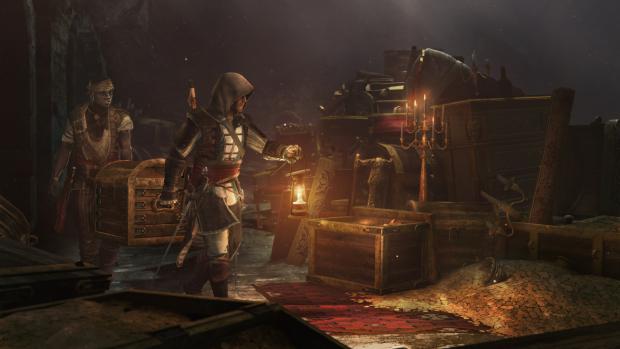
Perhaps at the top of the bill for pure immersion and entertainment are the treasure maps. Similar to the hastily-scribbled cartographs John Marsten can follow in Red Dead Redemption, the maps Kenway finds use visual clues and nautical coordinates to lead you to the treasure – which contains a sizeable amount of gold Reales and, quite often, a unique upgrade blueprint for Kenway’s ship, the Jackdaw.
What’s most impressive about Assassin’s Creed IV is how seamless it all is. Using a fast-travel point or causing a de-synchronisation will result in a load screen, but not much else will. For example, say you dock at one of the smaller island towns and feel like raiding a warehouse for upgrade materials (you are a pirate, after all): sneaking into the restricted area around the warehouse will trigger the side activity and you’ll be instructed to find the key-holder. How you do it is up to you, but looting the key will allow you to rob the warehouse provided you’re anonymous. After filling your cargo hold, it’s time to leave town – so you simply head to the docks and climb aboard your ship; a press of Circle (or B) will see Kenway take the wheel, and then you’re off, steering the Jackdaw the way you’d steer a vehicle in any other game. X speeds up, Circle slows down, L1 aims cannons and R1 fires them. Locating your next objective on your map, you head towards it, but as you enter restricted waters you’re spotted, causing an enemy ship to attack you. It’s all seamless, all slick – but what follows is, frankly, lightning in a bottle.
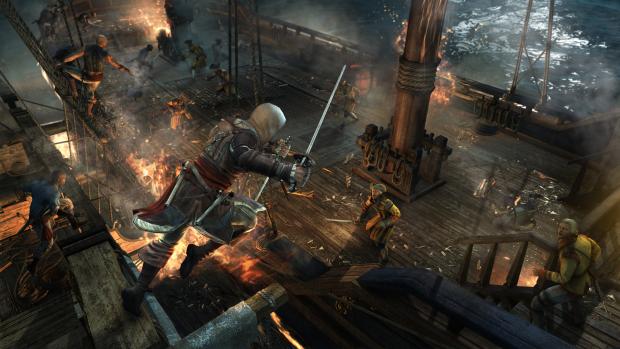
The ship-to-ship battles are by far the most exciting element of Black Flag, and the varying conditions (enemy ship size, weather, proximity to land, etc) make each one a genuine challenge and bring a tremendous sense of achievement. Circling the enemy to use your broadside guns always feels tactical, and throwing mortars and cannon volleys into the mix creates an atmosphere almost unparalleled. Once or twice you’ll find yourself engaged in a ship battle during a raging storm as lightning flashes and thunder crashes and the level of immersion is truly great. Batter your opponent enough and they’ll become incapacitated, presenting an opportunity to board them. Holding Circle at this moment will cause your crew to launch grappling hooks over to the other ship and storm her, but you can get across in several ways. Swimming is an option – as is using the swivel guns to weaken the resistance a little before engaging in close combat – but by far the most exhilarating way to storm an enemy is to race for the rigging, grab a rope, cut the ties and rocket yourself up the mast like Errol Flynn before hopping over to the enemy’s mast and air-assassinating the Captain from fifty feet up. Very few moments in gaming come close to the first time you do that.
Hand-to-hand combat is a familiar mix of countering and using tools. Pressing Circle when prompted will perform a parry, and then Square will despatch the attacker, Circle will throw him or Triangle will employ a secondary weapon like a pistol, throwing knife or smoke bomb. The fighting is smooth and responsive, but can become a little tedious once you’re fifteen hours in and are in a position to slaughter a dozen guards at a time without suffering a scratch.
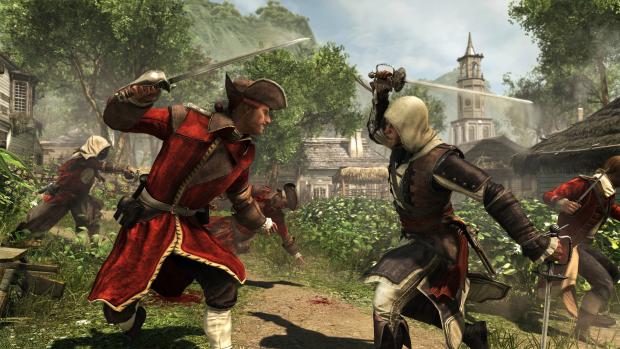
Slight issues with the combat are indicative of the broader problems with Black Flag. While the added elements are excellent and the seafaring is exceptional, the old weak links are still yet to be addressed. Crowd behaviour is still badly implemented: murder someone in a packed street and witnesses will gasp, maybe cower; but some will ignore it completely. Likewise, fighting and shish-kebabing three guards ten feet from one of their comrades is perfectly safe as long as he’s facing the other way, which can make it so easy to wipe out entire encampments of enemies. Collision physics are iffy during fights in tight spaces, and you’ll often see guards stuck through walls, or bumbling into one another like drunken dancers – and Kenway has a passion for running up absolutely everything. Holding R1 while facing the wrong direction by the merest of degrees during a high-speed chase can see you running half way up trees or perching on fences like an expectant cat mid-sprint. Also, impassable barriers make no sense in these games: why can you climb a church but not a rocky cliff-face? Because of engine limitations, and little else. It’s understandable, even excusable, but Black Flag comes so close to giving you true freedom that any restriction instantly grates.
But these issues are minor when examined as part of the full package. Ubisoft haven’t created an Assassin’s Creed game with pirates in, they’ve created a pirate game with Assassin’s Creed bits in it and, as such, there really is very little else like it. It will do for pirates what Red Dead Redemption did for the Old West, of that there is little doubt. The sound direction is bang on the money, from the voice-acting to the ambient sound effects; crashing waves and splintering timbers, cannon fire and roaring thunder – you need to hear it to fully understand what Ubisoft have achieved in regards to sound. Hitting the open seas, your crew will strike up in song, and you can cycle through shanties or tell them to shut up – but why would you?
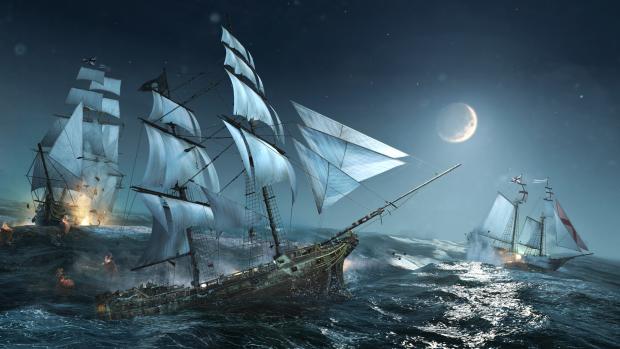
In aesthetic terms, Black Flag is the one of the best looking games of the year, not just for the detailed character models and the world itself but for the seamless integration of both. Nothing is bland or barren, nothing ever seems dull and listless. The world is vibrant, wild and untamed – but it doesn’t feel real, and nor should it. It feels like a pirate fantasy, which is exactly what it is. There is so much more to talk about in Black Flag, but to do so would ruin so many little surprises. There’s the crafting system borrowed directly from Far Cry 3, and the option to go hunting whales with harpoons, but these are just a few things that add layers to an already dense experience.
The multiplayer aspect has seen a few significant overhauls and has its fair share of new features. A decent tutorial is available to talk you through the basics, and the uninitiated will need it. Black Flag’s multiplayer is no free for all brawler; in fact, it’s often a game of far more finesse than the solo campaign. There are several modes and maps, but the name of the game is always assassination. Wolfpack mode returns, revamped and fleshed out to include its own campaign. Called “Discovery”, this cooperative mode is solidly built using a slightly dumbed-down version of the main game’s mechanics, and tasks teams with taking completing various assassination-based objectives in a handful of locations. There are also new team matches such as Domination, Black Flag’s version of King of the Hill. Most impressive is the Game Lab, a mode that allows you to create new versions of the offered matches, and lets you set specific conditions such as locking certain abilities or setting particular objectives.
With such a wealth of single player content there’s no need to linger just for the multiplayer, but Black Flag’s online modes are enticing. The differences between the multiplayer and the campaign keep it refreshing, and the atmosphere translates wonderfully. A host of new customisable assassins can be personalised with purchased upgrades and items unlocked in the campaign, so there’s plenty to keep you hooked outside of Kenway’s adventure.
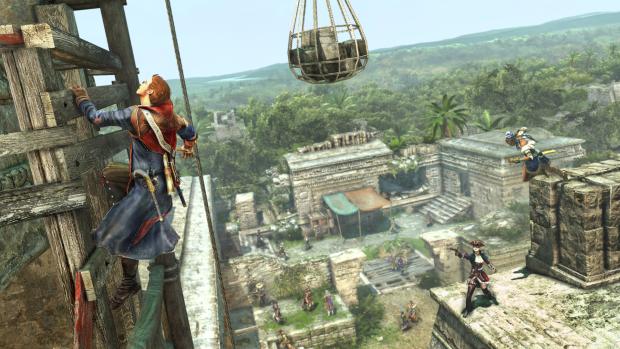
VERDICT: Though we can’t wait to see what Black Flag looks like on next-gen consoles, Ubisoft’s decision to release it on currently available machines was absolutely the right one. It’s yet another example of what the 360 and PS3 are capable of – a genuinely stunning creation that packs 40 to 50 hours of content into a beautiful, compelling world that begs to be explored.
It’s fitting that the final Assassin’s Creed on this generation should be the best yet, and Black Flag makes up for the perceived shortcomings of ACIII with a bullet; the fresh start and new modern day sub-plot even make it a great entry point to the franchise. Held back from true greatness by a smattering of small issues, Assassin’s Creed IV: Black Flag is a staggering achievement and a successful transition into fully open-world gaming. Spectacular.

SUPERB. This is the mark of greatness, only awarded to games that engage us from start to finish. Titles that score 9/10 will have very few problems or negative issues, and will deliver high quality and value for money across all aspects of their design.


